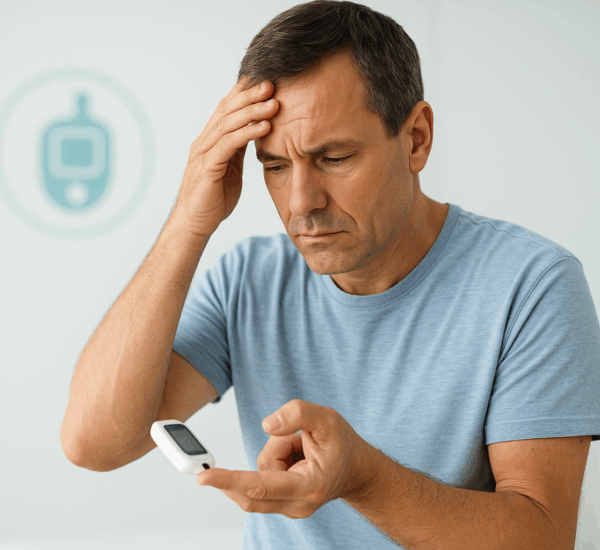Key Highlights
- Diabetes is a chronic condition affecting millions of women worldwide.
- Recognizing early signs is crucial for timely intervention and effective management.
- This blog post will highlight seven early warning signs specific to women.
- Understanding risk factors can empower women to take proactive steps toward prevention.
- Early detection and treatment significantly reduce the risk of complications.
Introduction
Noticing the early signs of diabetes is very important for quick action and diabetes management. Diabetes affects how the body controls blood sugar levels. If it’s not managed well, it can cause many health problems. This blog post will look at seven early warning signs of diabetes in women. By understanding these signs and the risk factors, you can take steps for early detection and improve your health.
7 Early Warning Signs of Diabetes in Women
Early diagnosis of diabetes is very important. It helps to stop health problems and begins needed lifestyle changes or treatments. Some symptoms of type diabetes are the same for everyone, but some signs affect women more. This part talks about signs that are often less obvious, but every woman should notice them. If you ignore these signs, it could delay diagnosis, leading to health risks.
Remember, knowing is important. Learning about these early signs is your first step to protect yourself from diabetes.
1. PCOS
Polycystic Ovary Syndrome (PCOS) is a common hormonal problem for women who can have children. It is linked to insulin resistance. This is when the body does not respond to insulin well. This resistance can cause higher glucose levels in the blood, which raises the chance of getting type 2 diabetes.
Women with PCOS may have irregular periods, gain weight, get acne, and have more hair growth. If you have PCOS, it is important to keep a healthy weight, exercise regularly, and watch your glucose levels closely.
Finding and managing PCOS early can help lower the risk of diabetes and other health issues. Regular visits to your doctor and talking about your symptoms are very important.
2. Infections
Frequent infections, especially urinary tract infections (UTIs), can be an early sign of diabetes in women. When blood glucose levels are high, it helps bacteria grow, increasing the risk of complications like foot ulcers. This means women with diabetes can get more infections.
If you notice that you are having UTIs, yeast infections, or skin infections more often, it is important to see your doctor. They can check your risk factors for diabetes and suggest the right tests, including monitoring for diabetic ketoacidosis, if needed.
Addressing the reasons for recurrent infections and keeping good hygiene is very important. Also, keeping blood glucose levels under control through lifestyle changes or medication can help reduce the number of infections in women with diabetes.
3. Blurred Vision
Experiencing blurry vision can be scary and should not be taken lightly, especially if it happens suddenly. It might be an early warning of high blood sugar that affects the tiny blood vessels in your eyes. When blood sugar is high, the lens in your eye can swell, which can cause temporary blurriness.
Usually, this issue goes away once blood sugar levels return to normal. However, if high blood sugar lasts for a long time, it can cause permanent damage, including nerve damage, that might lead to vision loss. If you often have blurry vision, getting help from a doctor right away is very important.
Your doctor can find out what is causing it and suggest the right treatment. Catching and managing high blood sugar early is key to avoiding problems with your eyes and keeping your vision clear.
4. Fatigue and Weakness
Feeling tired all the time and low on energy, even if you sleep well, might be a sign of high blood glucose. If your body does not make enough insulin or use it well, low blood sugar and glucose stays in your blood instead of getting to your cells for energy.
When your cells don’t get enough energy, you can feel weak and always tired. If you often feel exhausted for no clear reason, it’s important to talk to your doctor. They can check your blood glucose levels to see if diabetes is a reason for your tiredness.
Making some lifestyle changes can help. Eating a healthy diet and getting regular exercise can help control your blood glucose levels and reduce fatigue.
5. Increased Hunger
Increased hunger or a constant feeling of being hungry, even after eating, can mean that your body isn’t using glucose well, which is the main source of energy for your cells. Your body needs insulin to move glucose from your blood into your cells for energy. If your body doesn’t make enough insulin or if your cells resist it, glucose cannot get into the cells. This leads to low energy.
When your cells don’t get energy, your brain sends signals that make you feel hungrier, even if you just ate. This feeling can also come with other signs like needing to urinate a lot and feeling very thirsty.
If you keep feeling unusually hungry, it’s important to see your doctor. They can check if you have any medical conditions, like diabetes, that might be causing this issue.
6. Sudden Weight Loss
Losing weight on purpose by eating a healthy diet and exercising is good. However, losing weight quickly and for no clear reason can be a sign of diabetes, especially if you have other symptoms.
When your body can’t use glucose for energy because there is not enough insulin or because of insulin resistance, it starts to use fat and muscle for energy. This can cause you to lose weight quickly and a lot.
It’s important to keep track of your body weight. You should tell your doctor about any sudden or unexplained weight changes. Quick weight loss can also point to other health issues, so getting the right diagnosis is very important.
7. Frequent Urination
Frequent urination, especially at night, can be an early sign of diabetes. When your blood glucose level is high, your kidneys work hard. They filter out the extra glucose by making more urine.
This often means you need to use the bathroom more, especially at night. While wetting more than usual sometimes happens, a big increase in how often you go should be looked at by a doctor.
If you keep waking up at night to urinate or notice you are going more often, talk to your doctor. They can check your blood glucose levels and give you the right advice.
Understanding the Risk Factors for Diabetes in Women
It is important to notice early warning signs and understand the risk factors linked to diabetes for prevention. Some factors, such as family history of type 2 diabetes, lifestyle habits, and certain health issues, can increase your chances of getting this chronic condition.
By knowing these risk factors, you can make better choices to lower your risk. Living a healthy lifestyle, keeping existing health issues in check, and having regular health check-ups can greatly reduce your chances of developing diabetes.
Family History and Genetic Susceptibility
A family history of diabetes raises your chances of getting the disease. If you have a parent, sibling, or other close relatives with diabetes, you are more likely to have it too. This risk happens because certain genes are passed down through your family. These genes can affect how well your body makes and uses insulin injections.
You can’t change your genes, but knowing your family’s medical history can help you take charge of your health. Understanding your family’s health can lead to early detection through regular checks and changes in your lifestyle.
If you know diabetes runs in your family, talk to your doctor. They can help you understand your risk factors and what you can do to lower your chances of developing diabetes.
Polycystic Ovary Syndrome (PCOS) and Its Impact
Polycystic ovary syndrome (PCOS) is common in women who have diabetes. It can make insulin resistance worse, which means higher blood glucose levels. Women with PCOS face an increased risk of getting type 2 diabetes because of hormonal imbalances that affect glucose tolerance. PCOS can also lead to other problems such as fertility issues, irregular menstrual cycles, weight gain, and even heart disease. To stay healthy, it is important to manage both PCOS and diabetes with lifestyle changes and medication.
The Role of Obesity and Physical Inactivity
Obesity and not being active are major risk factors for getting type 2 diabetes. Too much weight, especially around the belly, can cause insulin resistance. This means your body’s cells do not use insulin well, which raises blood sugar levels.
Not exercising also makes this worse as it lowers how sensitive your body is to insulin. To reduce your chance of getting diabetes, a healthy lifestyle is very important.
Try to reach and keep a healthy weight by eating a balanced diet and exercising regularly. You should aim for at least 150 minutes of moderate exercise or 75 minutes of intense exercise each week.
Steps to Take if You Notice Early Signs of Diabetes
If you see any early signs of diabetes, it is important to see your doctor right away. They can help diagnose and manage the condition, and also provide essential patient education. Finding diabetes early is vital to prevent problems and handle it in the best way.
Your doctor may suggest a simple blood test to check your blood sugar levels. Based on the results, they will look at your risk factors. They can then suggest lifestyle changes, medicines, or more tests. Remember, acting quickly is important for managing diabetes well in the long term and keeping you healthy.
The Importance of Blood Sugar Monitoring
Blood sugar monitoring is very important for managing diabetes. By regularly checking your blood sugar levels, you can understand how your body reacts to food, medicine, and exercise.
This helpful information allows you and your doctor to make good choices about your treatment plan. Your doctor will decide how often you need to check your blood sugar based on what you need.
There are different ways to check your blood sugar, such as using finger-prick tests or newer continuous glucose monitors (CGMs). By taking part in blood sugar monitoring, you can have better control over your diabetes. This helps you live a healthier and happier life.
Conclusion
In conclusion, spotting the early signs of diabetes in women is very important for getting help quickly. Signs like PCOS, infections, and feeling tired can be warning signals. They encourage actions like checking blood sugar levels. Knowing risk factors such as family history and being overweight helps women take control of their health. By focusing on early detection and making lifestyle changes, it’s possible to lessen the effects of diabetes. If you see any of these signs, get medical advice quickly to protect your health. Stay alert, stay updated, and take care of yourself.
Frequently Asked Questions
What is the most common early sign of diabetes in women?
Frequent urination is often a clear sign of high blood glucose levels. This can be one of the first signs of diabetes in women. Other early signs include feeling very hungry, being very thirsty, having blurry vision, and having repeated urinary tract infections.
What are the first signs of diabetes in a woman?
The first signs of diabetes in a woman can be different. Some common signs are frequent urination, being very thirsty, feeling tired without a reason, sudden weight loss, and getting infections over and over. Women with PCOS might have a higher risk of developing diabetes.
How do you feel when your blood sugar is too high?
High blood sugar can show up as feeling very thirsty and hungry. You might also notice needing to urinate often, having blurry vision, feeling tired, and having dry skin. If you have any of these signs, talk to your doctor.
How to stop diabetes before it starts?
You can’t completely get rid of the risk of diabetes. However, you can lower it a lot. You can do this by having a healthy diet, staying active through regular exercise, keeping a healthy weight, and checking your blood glucose levels often to help lower blood glucose levels.
What are 5 common symptoms of a pre diabetic?
Five common signs of prediabetes and diabetes symptoms are increased thirst, frequent urination, tiredness you can’t explain, blurry vision, and getting infections a lot. These symptoms usually come from higher blood sugar levels. This means it’s time to make some lifestyle changes.








